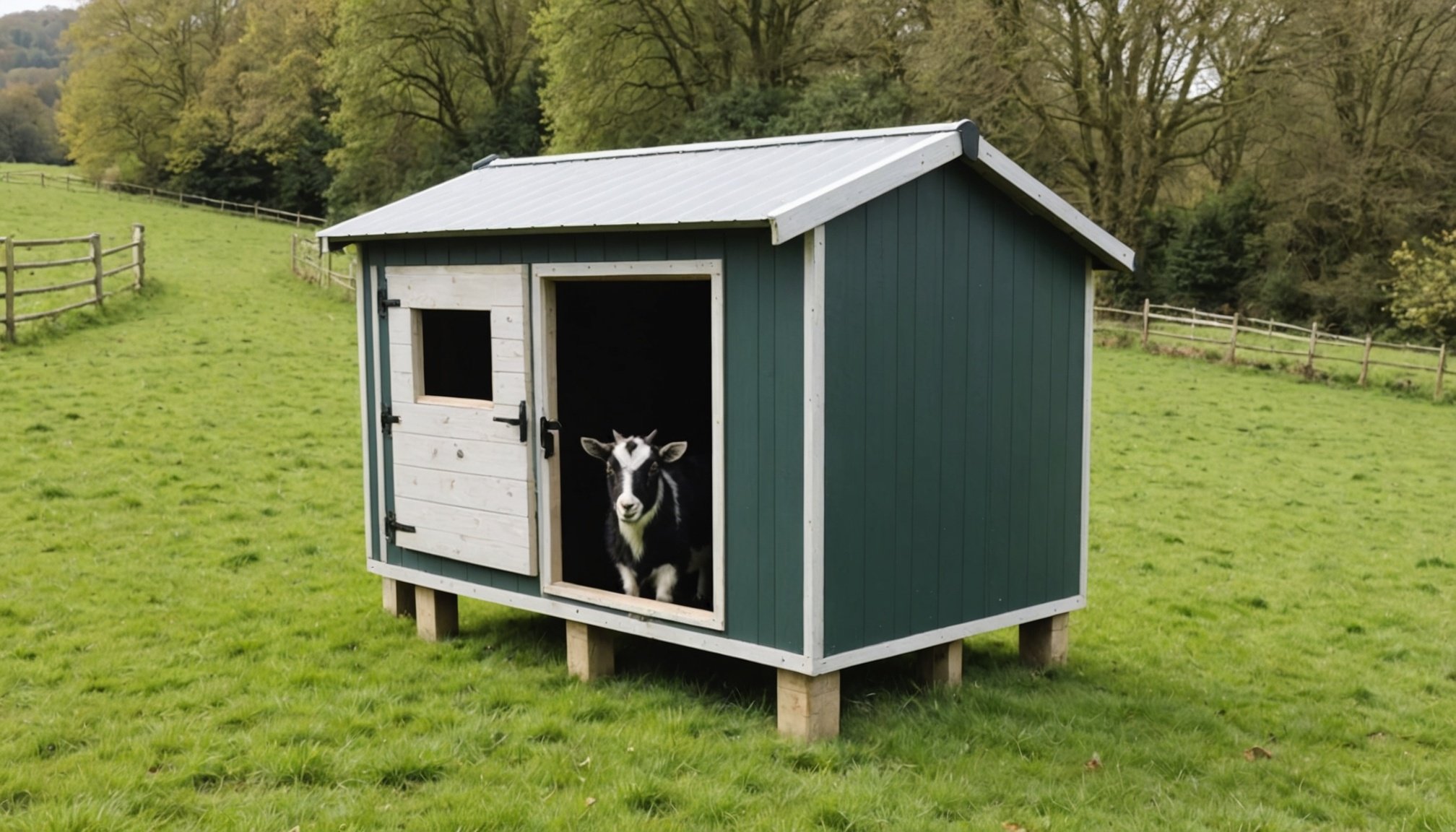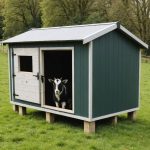Overview of Pygmy Goat Retreat Design
Creating an outdoor retreat design tailored for pygmy goats is essential, especially considering their unique characteristics and requirements. Pygmy goats are known for their social nature, agility, and curiosity. These attributes necessitate a space that offers both stimulation and security.
An outdoor area is not just a luxury but a necessity for the welfare of pygmy goats. They thrive in environments that allow them to roam freely, explore, and socialise. Inadequate outdoor facilities can lead to stress and behavioural issues, critically impacting their health.
Also read : Top Wildlife Cameras for Capturing Nocturnal Animals in Your UK Garden
Designing a retreat in the Welsh countryside provides additional benefits. The landscape, with its gentle hills and lush greenery, mirrors the goats’ natural habitat, allowing them to feel at ease. The countryside also provides clean air, ample foraging opportunities, and natural materials for shelter construction.
Key elements for a successful outdoor retreat design include:
Also read : Can norwich terriers thrive as perfect apartment pets in vibrant manchester?
- Enclosures that prevent escape and protect against predators
- Facilitating climbing and jumping with rocks or platforms
- Providing shady areas for relaxation and shelter from inclement weather
Choosing the Welsh countryside as a setting isn’t just picturesque but practical, fostering a harmonious environment conducive to the goats’ well-being and enrichment.
Elements of Safe and Functional Goat Housing
Creating safe and functional goat housing is essential for healthy livestock management. A sound goat housing design typically incorporates several key features to ensure animal safety and comfort.
-
Safety Measures: Strong and sturdy materials are crucial. Recommended materials include treated wood, galvanised steel, and sturdy wire mesh. Secure fencing prevents predators and keeps goats from escaping.
-
Ventilation: Proper air circulation is vital for the animals’ well-being. Ventilation reduces moisture and helps to control odours and temperature. This can be achieved by designing shelters with adjustable windows or vents to maintain airflow while avoiding draughts.
-
Outdoor Shelters: Outdoor shelters must protect goats from weather extremes. The design of outdoor shelters should include a sloped roof to keep rain from accumulating and raised floors to avoid dampness.
Furthermore, adequate space is essential. The space requirements for goats depend on size and breed, but generally, each goat should have at least 15 to 20 square feet of indoor space and access to an outdoor area.
Ensuring these features in goat housing not only enhances safety but also contributes to the animals’ overall health and productivity.
Fencing Considerations for a Secure Environment
Creating a secure environment for pygmy goats is crucial for their safety and well-being. Selecting the right goat fencing is essential. Pygmy goats are agile and curious, presenting a unique set of challenges for containment.
Types of Fencing Suitable for Pygmy Goats
The best options for pygmy goats include livestock panels, welded wire, and high-tensile electric fences. Each type of fencing offers different levels of security and maintenance needs.
- Livestock Panels: These are sturdy and designed to prevent climbing and jumping.
- Welded Wire Fencing: Offers a flexible choice but requires supplementary support.
- High-Tensile Electric Fences: Can deter climbing, but may not appeal to all goat owners due to maintenance considerations.
Height and Structure Requirements
A proper secure housing setup requires fencing at least four feet high to prevent escapes. Strategic landscape design plays a role, as inclines can make fencing less effective.
Maintenance Tips
To maintain secure fencing, regularly inspect for wear and tear. Ensure that no structures near the fence could be used as a launch pad for your goats. Correct installation initially alleviates many common issues in the landscape design phase itself, promising a secure environment for your goats.
Integrating Landscape Features for Aesthetic Appeal
Incorporating landscape design that balances aesthetic charm with functionality can transform your outdoor space. Begin by selecting goat-friendly plants that amplify visual appeal while ensuring the safety and nutritional needs of pygmy goats. Hardy varieties like lavender and rosemary offer a blend of colour and resilience, standing up to playful nibblers while beautifying the environment.
Natural elements such as rocks and logs seamlessly enrich outdoor aesthetics. Arranging these elements strategically not only mimics natural habitats but also provides essential climbing and resting spots for goats. This incorporation of natural materials can create a soothing and visually appealing ambiance that complements any garden setting.
Creating pathways interspersed with delicate foliage and purposeful enrichment features is another aspect of intelligent landscape design. These pathways, lined with durable and non-toxic plants, guide the goats and add an inviting flow to the outdoor space.
Consider inclusion of playful structures that engage the inherently curious nature of goats. This combination of form and function results in an engaging habitat that’s visually pleasing.
Outdoor aesthetics, when coupled with understanding of animal behaviour, lend to a vibrant, functional garden where both humans and goats can thrive.
Safety Measures to Protect Pygmy Goats
Ensuring the safety of pygmy goats involves a strategic approach focusing on goat care and safety measures tailored to their unique environment. In outdoor retreats, particularly in the Welsh countryside, safeguarding these goats from predators is crucial. Building sturdy, predator-proof shelters with secure fencing can provide essential protection, highlighting a key element of goat care. Elevated platforms and enclosed areas keep goats safe from foxes and other potential threats nocturnally.
Beyond predator management, monitoring environmental hazards is imperative. Natural challenges such as uneven terrain or poisonous plants require regular inspections and maintenance routines to prevent accidents or health issues. Installing weather-resistant fences and avoiding areas prone to flooding or landslides can further safeguard these delicate creatures.
Routine health checks play a significant role in maintaining the wellbeing of pygmy goats. Veterinary visits should focus on regular vaccinations, deworming, and overall physical assessments, demonstrating proactive safety measures. Paying attention to the nutritional diet and hydration also contributes to robust health, amplifying preventive care.
By implementing these comprehensive safety measures, goat owners in outdoor settings can ensure a healthy, secure lifestyle for their pygmy goats, integrating both enjoyment and protection into each outdoor retreat.
Maintenance Tips for Long-term Care
Taking care of a goat retreat requires consistent attention to ensure the environment remains inviting and sustainable. Implementing seasonal maintenance tasks is crucial to keeping the retreat both safe and appealing. Cleaning shelters regularly to prevent the build-up of waste and checking for repairs will maintain goats’ health and comfort year-round. In spring and summer, check fences and repair any damage caused by harsh weather conditions.
Incorporating sustainable practices serves not only the welfare of goats but also contributes positively to the environment. Utilising solar-powered water systems ensures that water sources are both reliable and eco-friendly. Planting native vegetation not only provides natural food sources but also supports local biodiversity. Composting waste from the retreat can be transformed into nutrient-rich soil, which is beneficial for gardening efforts within the facility.
For effective outdoor retreat management, investing in the right tools and resources is paramount. Electric fencing systems can prevent predators while allowing goats the freedom to roam safely. Capable transport equipment helps in the seamless relocation of goats when necessary. Educational resources, like workshops or online courses, enhance knowledge on goat care and retreat maintenance. Following these strategies contributes to a well-maintained, sustainable outdoor retreat.
Inspiration for Creating a Charming Atmosphere
Transforming outdoor spaces into charming environments can be both an art and science, especially when considering the unique needs of goats. Innovative design ideas not only boost aesthetic appeal but also cater to the well-being of these curious creatures. Creativity in design can drastically enhance the charm and functionality of goat habitats.
Aesthetics play a pivotal role in stimulating goats’ senses and promoting their health. Thoughtful incorporation of textures, colours, and shapes can keep goats engaged. For example, rustic fences, natural climbing structures, and pathways can create an inviting atmosphere.
This charming ambiance is not solely for aesthetic delight but also impacts goat behaviour positively. Engaging environments encourage exploration and reduce boredom, which are crucial for maintaining their well-being.
In rural settings, some remarkable goat retreats showcase these creative design principles. These idyllic environments often include:
- Varied terrain to navigate
- Interactive structures for play
- Harmonious planting schemes
These examples highlight how integrating functionality with charm creates a vibrant habitat. Such settings do not just captivate the goats but also enchant human visitors, offering a glimpse into the joyful lives of these fascinating animals.











